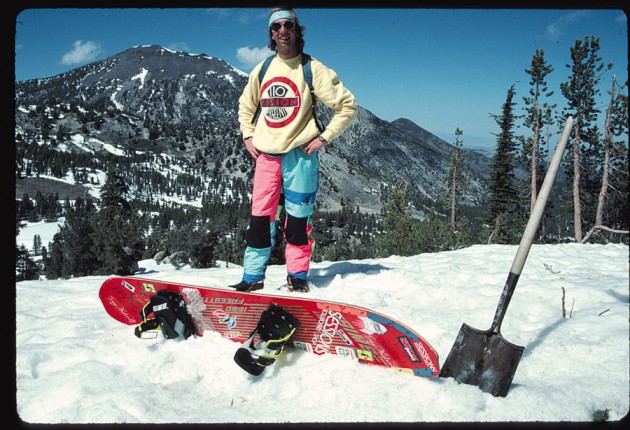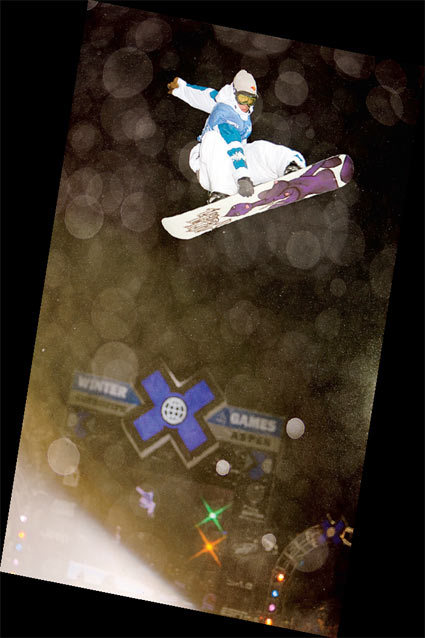Jake Burton Carpenter Tries to Ban Halfpipes from Competitive Snowboarding

Words: Chris Moran
Photography: Bud Fawcett
To understand this tale, one must go back to the late 1970s, when the snowboarding world was divided into two camps. On the east coast of the States, Jake Burton Carpenter was part of a group of pioneering riders who were primarily racing enthusiasts, while on the west coast, ex-skateboarding world champ Tom Sims was taking snowboarding in more of a freestyle direction. The two schools met, fittingly, in the middle of the country, when the very first pan-USA snowboard competition – the ‘King of the Mountain’ – was held at Ski Cooper in 1981. Sims claimed that his advanced equipment was well suited to hard pack conditions, and he trained for the slalom event in full view of his contemporaries. “Right out of the shoot,” said Sims in the recent book The Way of the Snowboarder, “I’m at loggerheads with Jake Burton.” According to Sims’s version of the story, Burton pressured the contest organiser to race the boards down a straight course with no turns because he knew he had no chance against Sims’s quick-turning board.
The following winter, a strange quirk of fate saw Tom turn his thoughts towards freestyle riding, when a dumper truck cut a small valley into the hill on the outskirts of Tahoe City. The tiny local snowboard scene turned the cutting into what is now considered the world’s first snow halfpipe. Tom and his Sims team were some of the first riders to session the shaped snow, and following a trip to Vermont to compete in yet another ‘race’ style snowboard event, Sims became convinced he should take snowboarding down this new skate-inspired avenue instead. “I felt I had to do the World Snowboard Championships in Lake Tahoe, where we’d have some nice turns, we wouldn’t be going straight down the hill, and we’d have a halfpipe.”

The contest ran in 1983 at Soda Springs, and the East Coast riders made the long trip across country to be confronted with something they’d never seen before – a halfpipe made out of snow. “Burton took one look at the Sims riders coming down the halfpipe,” said Sims, “and formed a boycott.” Transworld Snowboarding Magazine wrote: “Burton team members felt halfpipe had nothing to do with snowboarding and should not be considered for the overall [title].”
Others agreed that Sims had pulled a fast one: without any prior warning he had instigated a category that only his riders had had any practice riding! “It probably wasn’t the fairest way to do it,” said Tom Hsieh, editor of International Snowboard Magazine. Others accused Sims of rigging the slalom event too, setting a course down which his boards worked best and giving an unfair advantage to those riding on the Sims brand. “Given that no one else was organising contests, it wasn’t so far out of the ordinary,” said Hsieh, “he was always very competitive.”
For his part, Sims claims Burton’s refusal to ride the pipe stemmed from a deeper wish to take the sport into a more race-defined direction, rather than because he felt at a disadvantage. “Burton said to me: I don’t want snowboarding to be like skateboarding, with teams and pro riders,” claimed Sims in a recent interview, “because that is what I feel hurt that sport.”
What happened next:
Jake Burton’s subsequent actions perhaps dispel the idea that he didn’t like the freestyle direction Tom was trying to take snowboarding in. He returned to Vermont, where he worked with Paul Graves – who had previously set up a snowboard contest – on a new event. By 1985 this joint venture had become known as the US Open, and by 1988 it featured a halfpipe. You can just imagine Sims’s face contorting to read, in Burton’s literature, that this new pipe “was immediately deemed the standard for all other competitive halfpipes to follow.” One year previously, in 1987, Burton had also tempted Sims’ star freestyle rider Craig Kelly to ditch the Californian company and join the Burton team. It is an event that still irks Tom. “When Craig was unexpectedly recruited away,” said Sims recently, “the huge setback to the Sims team and our company was overwhelming.” Kelly went on to win five consecutive world halfpipe titles. Burton and Sims remained at the cutting edge of snowboarding technology throughout the 1980s, pioneering and marketing many of the technological advances we take for granted today, but by the mid 90s Burton Snowboards had started to dominate the market, while a series of business disasters befell Sims. “It’s been frustrating to me not to be able to hook up with partners who had either the passion or vision or financial resources necessary to be real successful,” he said recently, “So many of the early pioneers of the sport have gone due to lack of funding.”
Burton found no such problems, and today his company is still privately owned, holds over 50% of the worldwide snowboarding market, and undoubtedly has the best team on its books – including Shaun White, the world’s undisputed best halfpipe rider. Tom Sims recently re-launched Sims Snowboards under a licensing contract, through Collective Licensing International. The amount of influence Tom has on his company is debated here. To see Tom in action in 1983, click here or to see a fantastic news piece from the World Championships in 1986 click here


